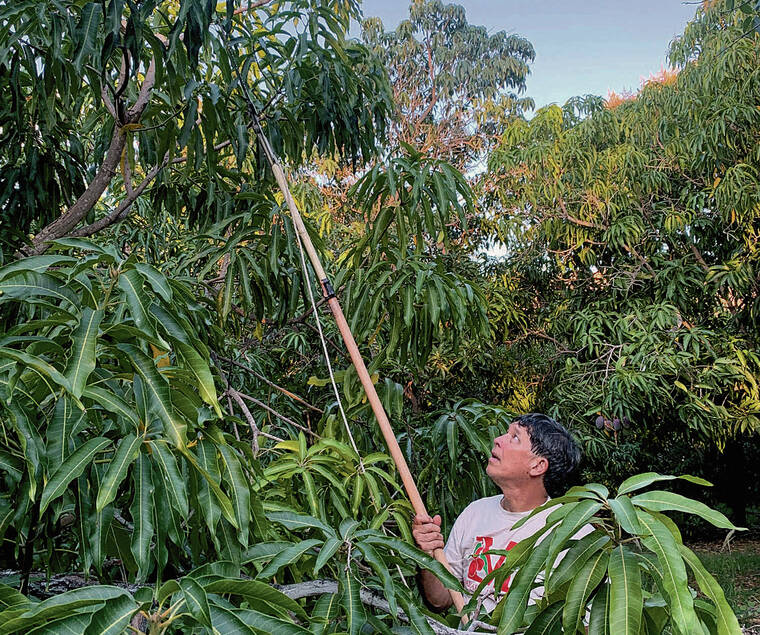Now that the last mango has been picked and your tree seems to have doubled in size, it’s time to trim the branches sprouting over the roof and encroaching into the neighbor’s yard.
For most people, their tree is just too big for their yard, says Makaha Mangoes grower and consultant Mark Suiso. It may have been fine for the first 10 to 15 years after they planted it, but often, it has grown to an unmanageable size.
“In the older neighborhoods, you see trees that are 50 years old and 50 feet high. … it’s just a problem of no maintenance,” he said. “For most people a tree over 20 feet is just too much work.” It gets harder to pick the fruit, and mangoes growing above the roofline just get overripe and fall to the ground.
He recommends hiring a tree trimmer or arborist to gradually prune the tree so it’s no higher than the roofline, he said. To get a towering tree under control, it should be cut back in three phases over five or six years, and unfortunately it’s not inexpensive. Suiso warned that cutting more than 10% to 20% of the leaf canopy at a time would shock the tree, and it may not produce mangoes the following year.
“The main message is: It’s not once and done. It’s a matter of picking where you want it to grow, having it cut back, then managing the growth that comes back.”
It’s all too common for homeowners to hire someone to cut the branches down to stumps and then do nothing, only to be frustrated when the tree grows back to the original size a few years later. To prevent the tree from getting too tall, Suiso said the trimmer should cut the larger branches going up toward the sun, and to keep the lateral branches growing sideways. He would also cut the branches in the center to allow more light and air into the middle of the tree for optimum fruit development.
One way to encourage lateral branches to grow is to tie cables around them to keep them growing sideways. Because younger branches are easier to manipulate, the current trend is to train a tree while it’s young so that when it’s 40 years old, it’s still small enough to harvest and maintain easily, Suiso said.
Once the tree is of a manageable size, he recommends thinning out the leaves and branches every other year, because if its leaves are too thick, sunlight and airflow can’t penetrate, and it’s harder to pick the mangoes.
Sometimes homeowners need to decide if a towering tree is worth the trouble and expense of maintaining, and consider cutting it down and starting anew. Most homeowners want to keep a tree because their grandparents planted it, or it’s associated with fond childhood memories, Suiso said.
They should evaluate the genetics of the tree to determine its growth habits alongside any space limitations — basically, “a tree wants to be big, it has a big root system.” That’s one advantage of planting dwarf trees, he said. Gardeners should consider the overall environmental conditions, including how much rain and sun their area gets. Thirdly, they need to commit to controlling its growth on a regular basis.
If the owner is tired of the original fruit, one option is to work with a graftsman to graft two or three different mango varieties onto the old tree once it’s of manageable size. Suiso said multiple grafting is “not a common practice, but we hope to build the skill level” in the state. He recommended the University of Hawaii’s Master Gardener program for assistance on grafting, pruning and other topics.
At Makaha Mangoes in Waianae, Suiso grows over 70 trees and at least 12 different varieties — “we keep experimenting”— as a wholesaler to stores and restaurants on Oahu. His father, Reuben Suiso, started planting the trees over 60 years ago in Makaha, where the hot sun and heavy soil were ideal.
Suiso also addressed the wisdom of homeowners trimming trees by themselves: If they have to climb a ladder, it can get dangerous in the same way it’s risky to pick fruit by climbing onto the roof. Larger trees usually require professional trimmers, as the average yard man is not trained in the art, he said.
Suiso is available for consultation and tree trimming. He also will answer questions from homeowners about their mango trees.
—
Makaha Mangoes
84-370 Makaha Valley Road
>> Info: 808-226-0092; email mark.suiso@gmail.com
>> A video on Suiso pruning mango trees can be viewed at vimeo.com/415664213/8ca5a9b487 Opens in a new tab.
>> For more information on mango care, visit makahamangoes.com/mango-university Opens in a new tab, which provides links to the College of Tropical Agriculture & Human Resources and other sources.
>> For advice from the UH Master Gardener program, visit ctahr.hawaii.edu/UHMG Opens in a new tab.
Is there a gardening topic you’d like to read about in the Garden Variety column? Email Pat Gee at pgee@staradvertiser.com with your request.

